Hawaii, with its lush tropical climate, is home to a diverse range of palm trees that contribute to the island’s iconic landscape. Hawaii’s palm trees include many different species, each adding its own unique character to the landscape.
Whether lining sandy beaches, shading urban streets, or accenting garden settings, Hawaii’s palm trees epitomize the island’s tropical beauty, providing shade and a connection to the rich natural heritage of Aloha State.
Different Types of Palm Trees in Hawaii
Florida Royal Palm
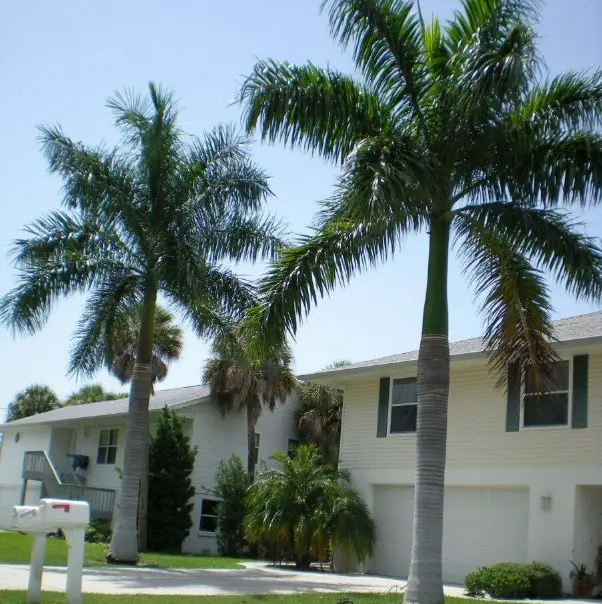
Commonly found in Southern USA states, the majestic and towering Florida Royal Palm (Roystonea regia) is a palm tree of great stature. It is distinguished by its huge, fluffy fronds that are 13 feet (4 meters) in length and its slender, cylindrical gray trunk, standing at a height of 100 feet (30 meters). In addition, the palm produces eye-catching clusters of blooms that eventually turn into violet-blue, egg-shaped fruits.
A smooth green crown shaft, fibrous roots at the base of the trunk, and discernible rings encircling the brownish-gray trunk are distinguishing characteristics. These palms, also known as the Cuban royal palm, are common in Southern California, Texas, Florida, and Hawaii, where they enhance the majesty and grace of the surrounding surroundings.
Areca Palm
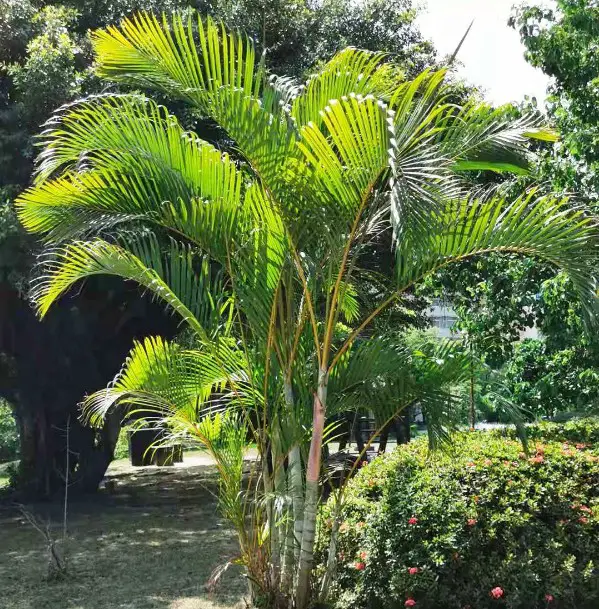
Popular in Hawaiian landscapes, the Areca palm (Chrysalidocarpus lutescens, also known as Dypsis lutescens) is distinguished by its multi-trunked look and bushy evergreen foliage. Large feather fronds spanning 5 to 7 feet (1.5 to 2.1 meters) long and bearing 90 to 110 strap-like leaflets apiece adorn this lovely palm.
It produces clusters of vivid yellow flowers in late summer, which are followed by orange palm fruits. Growing 12 to 30 feet (3.6 to 9 meters) tall and 15 feet (4.5 meters) broad, the Areca palm is a tall plant. Its cane-like yellowish-green ringed stems and curled fronds that mimic butterflies are among its striking characteristics.
Bismarck Palm
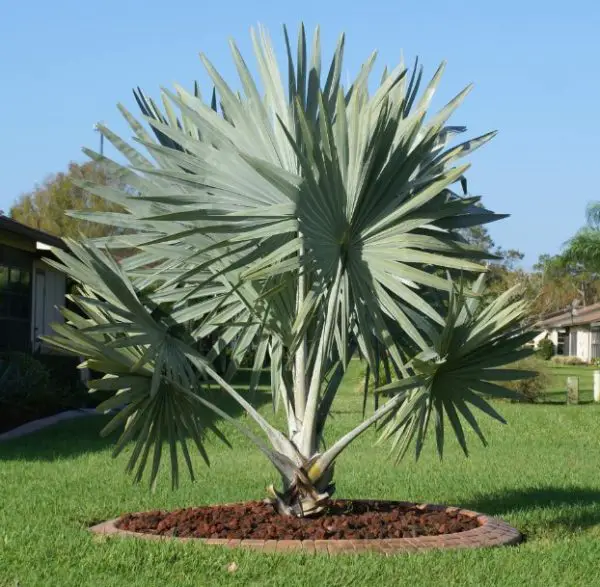
A magnificent focal point in gardens around Hawaii, the Bismarck palm (Bismarckia nobilis) is a stunning tropical tree recognized for its exquisite silvery-gray leaf. The enormous, fan-like fronds of this stately palm have a silvery-blue color and grow in a circular, spiky pattern, about 4 feet (1.2 meters) in length and width. Beneath the leaves are arching branches that bear brown flower clusters and oblong fruits.
As a specimen tree or on a groomed lawn, the Bismarck palm, with its sturdy, jagged trunk and lovely canopy, makes a striking impression. It is as tall as forty to seventy feet (12 to 21 meters) and as wide as fifteen feet (5 meters). Apart from its widespread usage in Hawaii, this palm tree is also extensively employed in landscaping in California.
MacArthur Palm
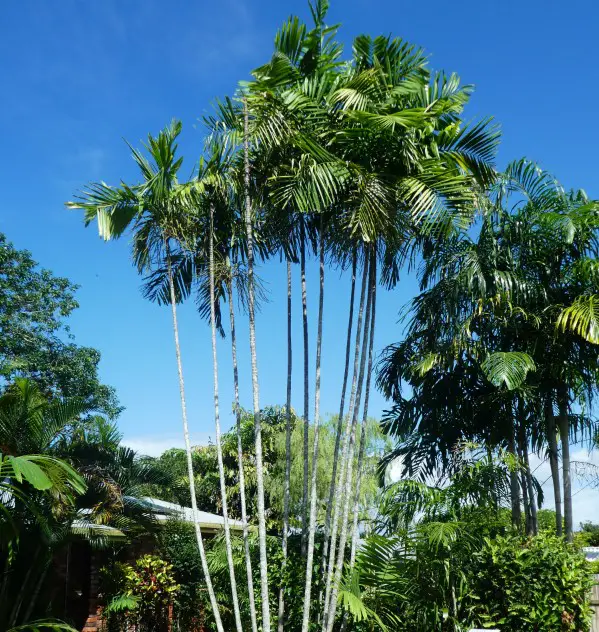
The MacArthur palm (Ptychosperma macarthurii) is a tree that stands out in Hawaiian landscapes due to its numerous tall, slender trunks that resemble bamboo. With several branches, this tree has a green crown shaft and a rounded, spiky crown that is covered in fluffy, flat fronds that grow up to 10 feet (3 meters) long and bear 30 to 80 leaflets per. On each stem, eight to ten leaves form an uneven canopy.
The MacArthur palm can grow between 22 to 30 feet (7 to 9 meters) tall. Its clumping growth habit, smooth white-gray trunks swollen at the base, and large clusters of red fruits make it easily recognizable and aesthetically pleasing in gardens and natural settings.
Triangle Palm
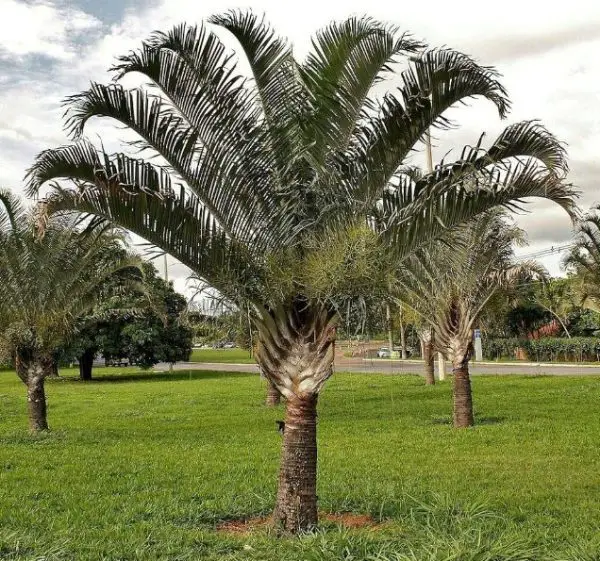
The little, exquisite Triangle Palm (Dypsis decaryi) is distinguished by its elegantly fanning pinnate fronds that emerge from a single trunk. The fruits of this palm are marble-sized and creamy white, with a stocky trunk. The feather fronds of the Triangle Palm are incredibly beautiful. They can reach up to 10 feet (3 meters) in length and spread out in a manner akin to a peacock strutting its feathers.
The Triangle Palm is perfect for tropical climates like Hawaii, where it can reach heights of 25 to 30 feet (7 to 9 meters) and widths of 12 to 15 feet (3 to 5 meters). It is resilient to high winds and drought, and it grows well in USDA zones 10 through 13.
Blue Latan Palm

The beautiful silvery-blue foliage of the Blue Latan Palm (Latania loddigesii) makes it stand out and is a great fit for Hawaii’s coastal regions. The impressive canopy of this palm tree is made up of rigid fan fronds with red edges and a silvery-blue hue that spans 8 feet (2.4 meters) in width and 5 feet (1.5 meters) in length on top of petioles. Under these striking leaves, flower stalks reaching a height of six feet (1.8 meters) give way to brown fruits that are one inch (2.5 centimeters) in diameter.
The Blue Latan Palm, which grows to a height of 20 to 25 feet (6 to 8 meters) and a width of 10 to 15 feet (3 to 5 meters), is a popular landscaping option because it can tolerate the salty air and sandy soil of Hawaii’s coastal surroundings.
Red Sealing Wax Palm
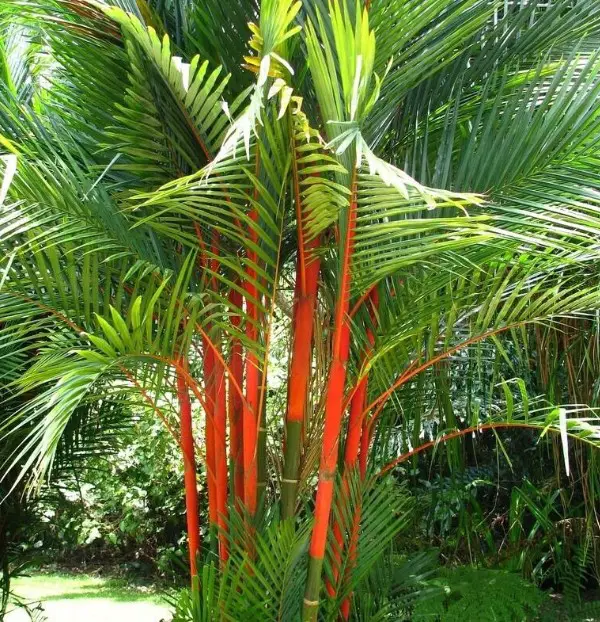
Grown in Hawaii’s tropical climate, the Red Sealing Wax Palm (Cyrtostachys renda) is a unique little tree that is well-known for its vivid red leaf stalks. With its striking, brilliant red crown shaft and frond sheaths, this palm tree stands out and gives landscapes a distinctively tropical feel. It has tiny, black fruits in the shape of eggs, and its lush, green, pinnate fronds grow to a height of 4 to 5 feet (1.2 to 1.5 meters).
Often called the lipstick palm, this species reaches heights of 25 to 35 feet (7 to 11 meters) and widths of up to 20 feet (6 meters) across its crown. In sunny tropical gardens, it makes a perfect specimen, hedge, or screen plant.
Alexandra Palm
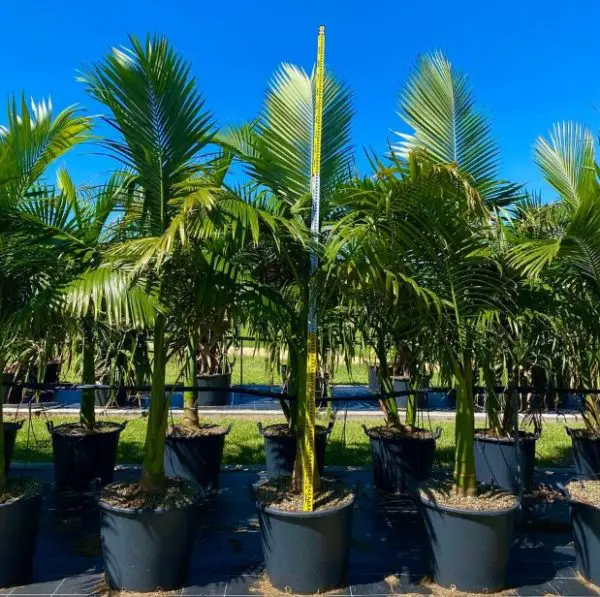
Hawaii’s tropical environments are ideal for the beautiful Alexandra palm (Archontophoenix alexandrae). This graceful palm is distinguished by its huge clusters of red, green, and yellow blooms, as well as by its solitary gray stem and vast crown of feather fronds. The trunks frequently have a characteristic bulge at the base.
Alexandra palm trees can grow up to 100 feet (30 meters) tall and have a noticeable 3 foot (1 meter) green crown shaft. Its fluffy leaves can grow up to 15 feet (4.5 meters) long and up to 160 leaflets each, giving Hawaiian gardens and natural environments a rich, colorful appearance.
Carpentaria Palm

The Carpentaria Palm (Carpentaria acuminata) is a sun-loving, fast-growing tropical tree commonly found in Hawaii. This solitary palm is characterized by its slim, erect trunk and crown of large, arching feathery fronds. These impressive fronds can reach lengths of 10 to 15 feet (3 to 5 meters) and emerge from a smooth green crown shaft.
Known for its ornamental value, the Carpentaria palm can grow between 30 to 100 feet (9 to 30 meters) tall. Its bright green, feather-like fronds contribute to its tropical allure, making it a popular choice for landscaping in Hawaii’s warm climates.
Pigafetta filaris
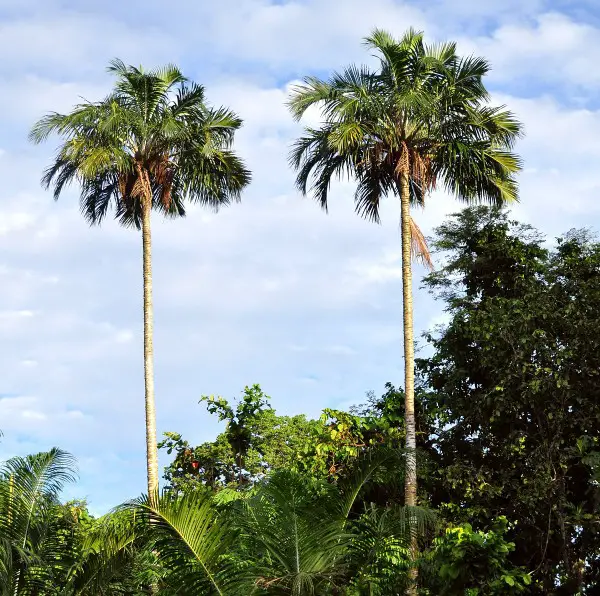
One of Hawaii’s tallest palms, Pigafetta filaris, reaches heights of up to 164 feet (50 meters). With its long, fluffy fronds and thin stem, this gorgeous palm tree lends a touch of tropical elegance to Maui’s gardens and woodlands. The fronds of this stately palm can reach a length of 20 feet (6 meters), and they are decorated with 3 feet (1 meter) of strap-like leaflets.
Pigafetta filaris is well-known for its adaptability; it grows quickly in warm, humid regions with constantly moist soil and thrives in a variety of soil types. It is a preferred option for improving Hawaiian landscapes because of these qualities.
Palmetto Palm Tree
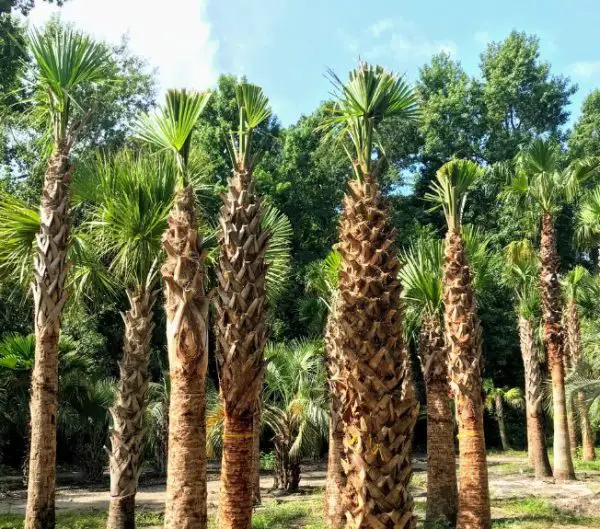
Tall and quickly growing, the palmetto palm tree (Sabal palmetto), popularly called the cabbage palm, is typically found in tropical regions such as Hawaii. Its wide, fan-shaped fronds on top of a slender stem define its appearance. The elder brown leaves on these fronds, which may grow up to 6 feet (1.8 meters) in length, drape elegantly around the trunk and wave softly in the breeze.
The Palmetto Palm’s unique appearance is enhanced by its trunk, which is coarser near the crown and smoother at the base. This tropical palm tree can reach heights of 40 to 50 feet (12 to 15 meters) and is noted for growing quickly, gaining about 2 feet (0.6 meters) in height every year.
Peach Palm
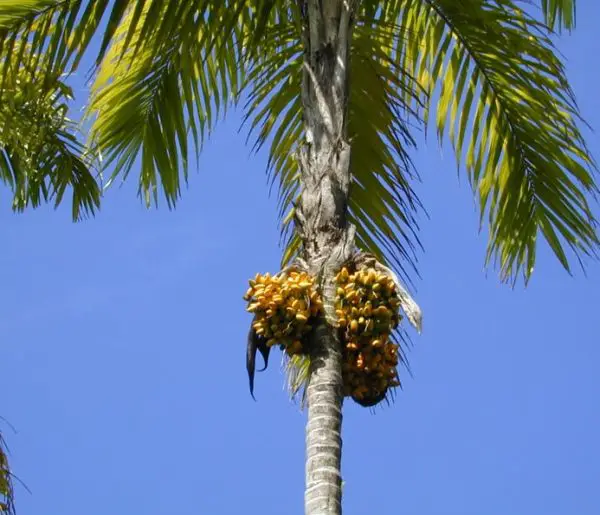
The unique sea-island palm known as the Peach Palm (Bactris gasipaes) is easily identified by its spiky trunk. This tropical tree has a circular crown of feather fronds and an upright, single stem. It may reach a height of 66 feet (20 meters) and features pinnate leaves that are up to 10 feet (3 meters) long and rest on 3-foot (1-meter) stalks. The fruit of the palm is edible once it flowers.
The Peach Palm is distinguished by its prickly trunk, which is covered with circular rows of firm black spines. This huge palm is a welcome addition to the local environment despite not being native to Hawaii since it flourishes without becoming invasive.
Foxtail Palm
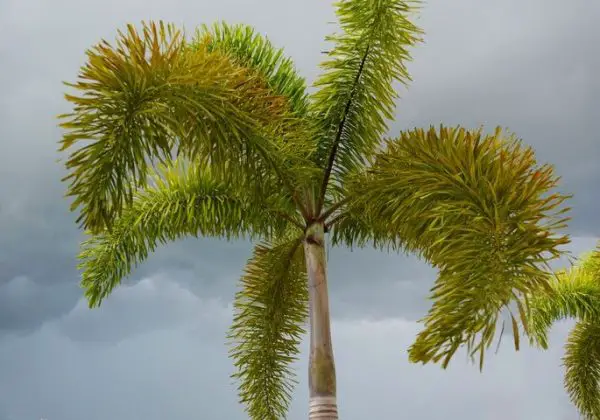
The Foxtail Palm, or Wodegetia bifurcata, is a medium-sized tree that grows best in Hawaii and Southern Florida. This tropical plant, which is well-known for its eye-catching look, has plumose fronds that resemble a bushy fox’s tail and enormous orange fruits that are roughly the size of duck eggs. The palm can reach heights of up to 30 feet (10 meters) and features a single, upright trunk.
In warm areas like Hawaii and sections of Southern Florida, its pinnately complex fronds can reach lengths of 8 to 10 feet (2.4 – 3 meters), contributing to its tropical attractiveness and making it a popular choice for landscaping.
Bottle Palm Tree

Small Hawaiian gardens are perfect for the Bottle Palm Tree (Hyophorbe lagenicaulis), an ornamental palm with a short, robust trunk. Because of its peculiar trunk shape, which resembles a rounded bottle, this palm is a noticeable sight in Hawaiian landscapes, parks, and along streets. It has a sparse crown of feather fronds and a smooth, green crown shaft.
The bottle palm, which grows to a height of 12 to 15 feet (3.6 to 5 meters) on average, is only found in southern Florida and Hawaii in the United States. It is a tropical plant that does best in warm conditions. When properly protected from cold weather and watered with caution, it can also be grown in containers.
Traveler’s Palm
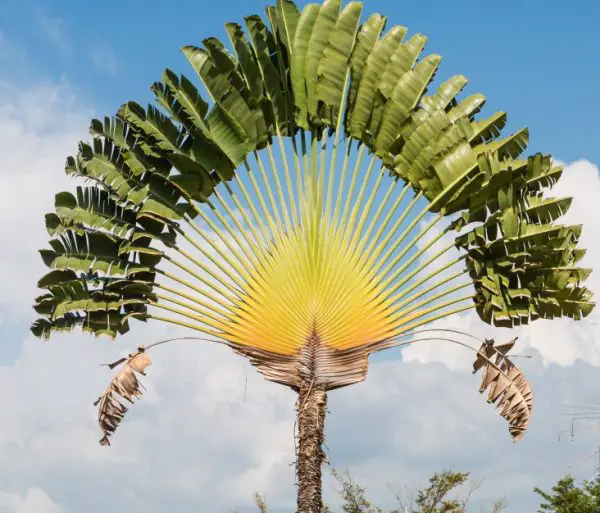
Though it is not a real palm, the Traveler’s Palm (Ravenala madagascariensis) is a stunning flowering tree distinguished by its unusually formed crowns. With up to 30 leaves per tree, its enormous, paddle-shaped leaves are arranged on long stalks to form a fan-shaped crown. Each leaf blade is 3 feet (1 meter) wide and 5 to 10 feet (1.5 to 3 meters) long.
Often misidentified as a palm, it is actually a member of the Strelitzia genus, which is linked to plants known as birds of paradise. The traveler’s palm adds a tropical flavor to a variety of landscapes, flourishing in frost-free areas in Hawaii, the Florida Keys, and southern California.
Loulu

Native to Hawaii, loulu palm trees (Pritchardia spp.) have a single trunk and huge fan fronds on stalks that can reach lengths of two to ten feet (0.6 to three meters). While some species have drooping or weeping branches, others have elegant, arching branches with pleated, spherical fronds.
Similar to other types of palm trees, Loulu palms bear enormous clusters of oval or spherical fruits beneath the branches at the top of the tree. These fruits range in size from 0.75 inches to 2 inches (2 to 5 cm), depending on the species.
Pritchardia remota
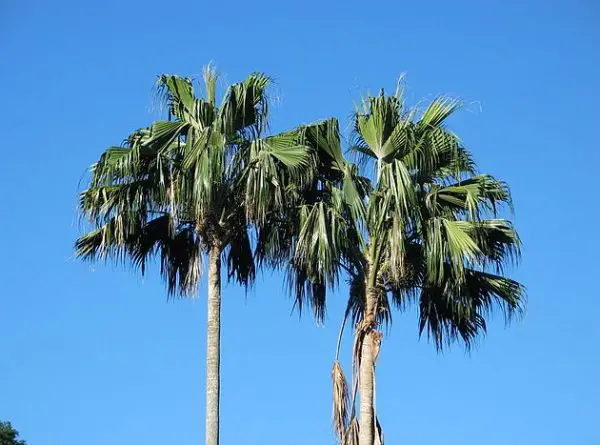
The tiny palm tree Pritchardia remota is native to the Hawaiian island of Nihoa and grows to a height of 13 to 16 feet (4 to 5 meters). It has a dense crown with fan-shaped leaflets that droop at the extremities, as well as a narrow, ringed trunk. Small, dark brown or black fruits are produced by this palm tree. A vital component of Nihoa’s natural environment, Pritchardia remota adds to the island’s exceptional biodiversity.
Pritchardia munroi

The short Hawaiian palm, Pritchardia munroi, can reach a height of 16 feet (5 meters). Its entire tree is covered in drooping fan fronds that nearly hide its wide trunk. The native forests of Molokai and Maui, two Hawaiian islands, are home to this palm. Pritchardia munroi is a distinctive member of the island’s flora, flourishing in a variety of habitats and contributing to the aesthetic appeal and ecological harmony of the tropical landscape.
Pritchardia arecina
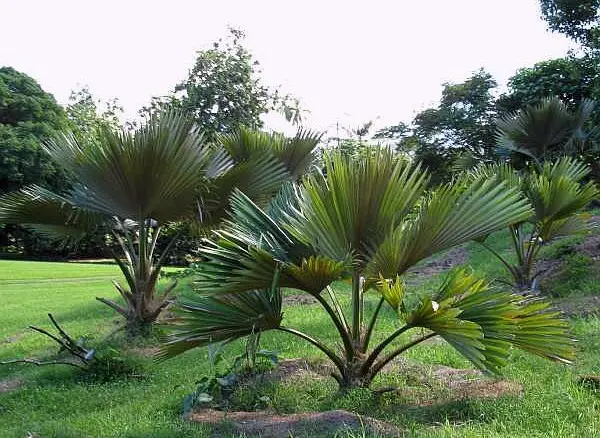
Growing from 30 to 50 feet (9 to 15 meters) in height, Pritchardia arecina is a medium-sized Hawaiian palm. Its huge, round, palmate leaves are on slightly arching stalks and are about 3 feet (1 meter) long. Native to East Maui, this palm species adds to the abundant biodiversity of the area. Pritchardia arecina enhances the ecological worth and visual attractiveness of Maui’s natural landscapes with its remarkable height and unique leaves.
Pritchardia beccariana
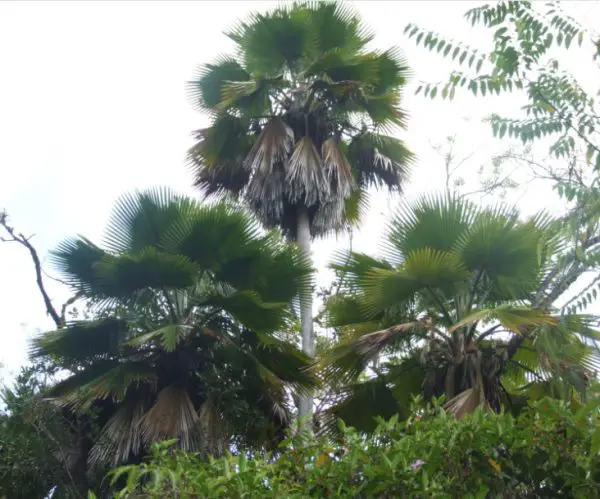
Pritchardia beccariana is a tall, slender palm characterized by its smooth, gray stalk and a spreading crown of flat fan fronds. The upper fronds extend at right angles from the crown shaft, while the lower ones tend to droop. Native to the eastern slopes of Mauna Loa on the Big Island, these palms contribute to the island’s unique ecosystem. Pritchardia beccariana adds to the diverse flora of the region, enhancing the natural beauty and ecological balance of Mauna Loa’s slopes.
Pritchardia glabrata
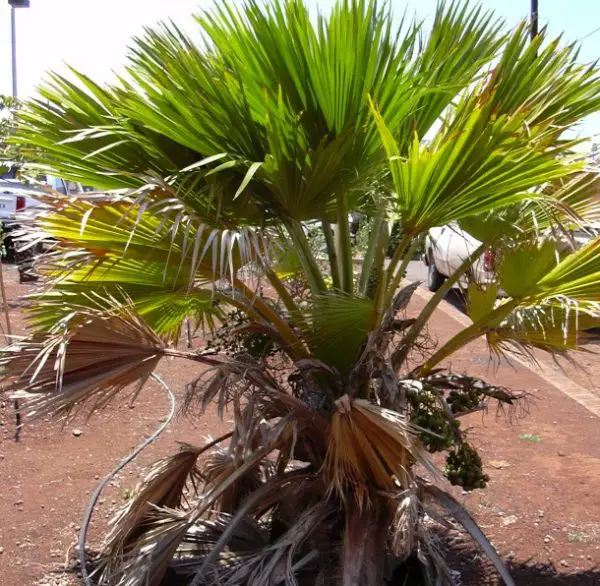
Pritchardia glabrata is a slow-growing dwarf Hawaiian palm that reaches heights of 6.5 to 16 feet (2 to 5 meters). It features an open crown with fan leaves, each approximately 2 feet (0.6 meters) long. This palm is native to Lanai and West Maui, contributing to the distinct flora of these regions. Despite its smaller size, Pritchardia glabrata plays a vital role in the local ecosystem, adding to the diversity and beauty of Hawaii’s natural landscapes.
Pritchardia lanigera
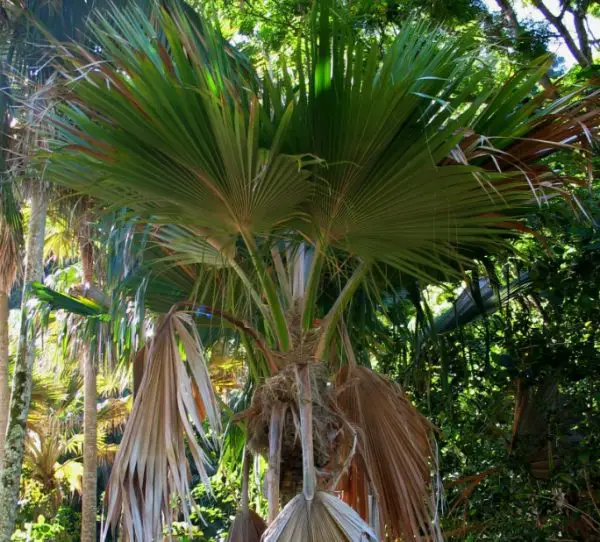
Pritchardia lanigera, native to Mauna Kea and Mauna Loa on the island of Hawaii, is an exotic palm that grows up to 50 feet (15 meters) tall. It features large, round fan fronds on relatively short petioles, creating a striking visual contrast. This impressive palm species contributes to the unique and diverse flora of Hawaii’s volcanic landscapes, enhancing the natural beauty of Mauna Kea and Mauna Loa while supporting the local ecosystem.
Coconut Palm
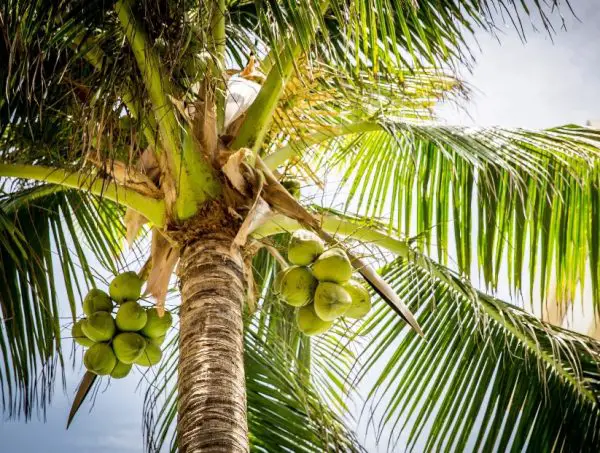
The coconut palm (Cocos nucifera) is one of the most iconic symbols of Hawaii, thriving in warm tropical conditions. This tall, stately tree features a single, often curved trunk, arching green pinnate fronds, fragrant yellow flowers, and characteristic coconuts. Coconut palms in Hawaii grow between 50 to 100 feet (15 to 30 meters) tall and have an open crown.
They bloom year-round with large clusters of yellow flowers, followed by hard coconuts. Introduced to the islands as one of the first non-native palms, coconut palms have become a beloved part of Hawaii’s tropical landscape.






